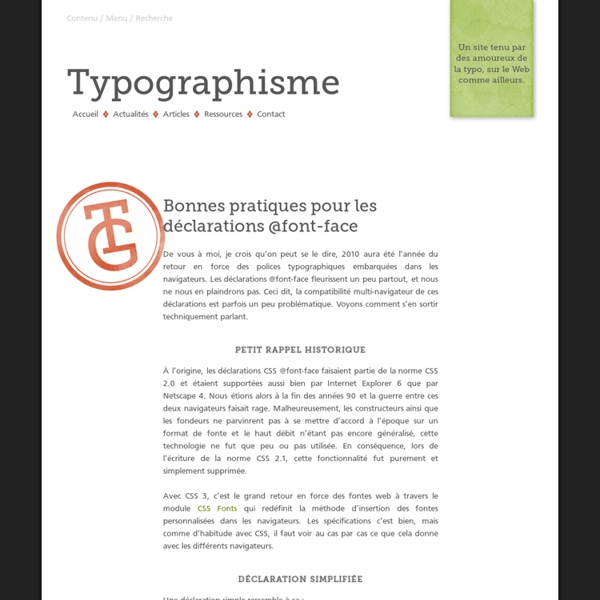Bonnes pratiques pour les déclarations @font-face

Typograph – Scale & Rhythm
This page falls somewhere between a tool and an essay. It sets out to explore how the intertwined typographic concepts of scale and rhythm can be encouraged to shake a leg on web pages. Drag the colored boxes along the scale to throw these words anew. For the most part, this text is just a libretto for the performance you can play upon it. Choosing sizes Don’t compose without a scale. Of course, good typesetting requires something more than selecting a series of font sizes, just as music consists of something more than choosing notes. Vertical Tempo Most pages of continuous prose pulse with a particular vertical rhythm, established by the lines of its main words, sentences, and paragraphs. For this, Bringhurst suggests another rule of thumb: Add and delete vertical space in measured intervals. Size and rhythm make each other interesting. Sizing up the <body> The first step: establish the size of the main text. Here, it pays to work with the grain. Declare <body> font-size using % The em
Conseils pour une bon titre d'article sur le Web
Étiquettes : lisibilité, principes formels, principes rédactionnels C’est quoi un titre d’article qui marche? On vous propose un inventaire des différents genres de titres qui marchent pour vos contenus Web. Pour trouver un bon titre d’article, il faut savoir ce que vous cherchez. Il existe deux grandes catégories de titres : Les titres directsLes titres indirects Les titres directs Ex. : Tout savoir sur l’écriture pour le Web Leur sens est littéral. Les titres indirects Ex. : En mal d’appât ? Ils exploitent une voie « oblique ». Dans ces deux catégories, on distingue des sous-catégories, telles que: Les titres impératifsLes titres « à la une »Les titres sous forme de questionLes titres « Comment… »Les titres « X bonnes raisons de »Les titres « témoignage » Les titres impératifs Ex. : Mettez de l’ordre dans vos titres ! On se souvient des pub Vittel « Buvez, éliminez » … Dans vos titres impératifs, le premier mot sera généralement un verbe qui encourage l’utilisateur à agir… Alors, convaincus ?
Modularscale
Comment utiliser une fonte «non-standard» sur un site Web
Il est de notoriété publique que l'usage des fontes sur le Web est limité à une poignée de fontes non pas standardisées, mais suffisamment répandues pour pouvoir être utilisées sans trop de risques. Et cela pour une raison très simple: la police de caractères que l'on souhaite utiliser doit être présente sur le système de l'utilisateur pour être utilisée par le navigateur. Quand @font-face tombe à l'eau CSS 2 (publié en 1998) comprenait un mécanisme qui autorisait les auteurs de pages web à proposer une fonte au téléchargement, fonte qui serait ensuite utilisée dans la page. la plupart des fontes disponibles sont protégées par le droit d'auteur et ne peuvent pas être redistribuées, y compris comme fonte «intégrée» à un site web; les fontes rajoutaient un poids conséquent aux pages (jusqu'à plusieurs centaines de Ko); les développeurs des navigateurs étaient peu enclins à affronter les deux problèmes ci-dessus (surtout le premier). Quand @font-face revient Google Web Fonts Font Squirrel
Code Style: Open standards Web design with CSS, XHTML, Java servlets and Javascript
03. Qu’est-ce qu’un angle ?
Tous les jours, les médias concurrents traitent les sujets importants. Sur un même sujet chacun peut constater que le résultat est différent d’une radio à l’autre. Tout dépend de l’angle choisi pour traiter le sujet. Si l’angle est bon, le reportage va intéresser. L’angle : une réponse aux contraintes pratiques du métier de journaliste. Il est impossible de donner toutes les informations dans un papier d’une minute. Quand déterminer l’angle d’un sujet ? Le moment pour choisir un angle de traitement d’un sujet, c’est la conférence de rédaction : comment on va traiter chaque sujet, qu’est ce qui intéresse les auditeurs dans ce sujet, qui sont les bons interlocuteurs pour une interview ? Exemples d’angles. Prenons un sujet d’actualité : un incendie fait rage dans un quartier de votre ville, les maisons et les commerces sont en flamme. Voici quelques exemples d’angles possibles : 1er angle : Envoyer un reporter sur place qui nous appellera dans le journal pour décrire l’incendie.
Related:
Related:



